Title: Supernova 2007bi as a pair-instability explosion
Authors: A. Gal-Yam, P. Mazzali, E. O. Ofek, P. E. Nugent, S. R. Kulkarni, M. M. Kasliwal, R. M. Quimby, A. V. Filippenko, S. B. Cenko, R. Chornock, R. Waldman, D. Kasen, M. Sullivan, E. C. Beshore, A. J. Drake, R. C. Thomas, J. S. Bloom, D. Poznanski, A. A. Miller, R. J. Foley, J. M. Silverman, I. Arcavi, R. S. Ellis, & J. Deng
First author’s institution: Benoziyo Center for Astrophysics, The Weizmann Institute of Science
Journal: Nature (closed access), arXiv
All stars die, but not all stars die the same. Some, like our Sun, will eventually fade away into a white dwarf. Some will explode as an iron core-collapse supernova and leave behind a neutron star or a black hole. Some will try to explode but won’t be strong enough and instead will collapse into a black hole. Some will explode and leave no trace behind. These special explosions with no trace are called pair-instability supernovae (PISNe) and only happen in the most massive of stars. Today’s paper from 2009 investigates a unique supernova, SN 2007bi, that was initially thought to be the first PISN ever observed.
What is a Supernova anyway?
At its core, a supernova is the fatal explosion of a star. There are two main types of supernovae with several subtypes below those. The two main types are called Type I and Type II and are separated based on the absence of Hydrogen in the supernova’s spectrum. Shown in Figure 1 is a supernova tree from Lamers & Levesque, 2017. Pair-instability supernovae don’t fall into any one sub-type, as they only depend on the mass of the progenitor.
Gotta Have Pair-Production if You Want Pair-Instability
Pair-production is the creation of a pair of particles from a photon interacting with some nucleus. In the context of Pair-Instability SNe, “pair-production” refers to the creation of an electron/positron pair from the interaction of a gamma-ray photon with an oxygen nucleus. Pair-production can only happen if the gamma-ray photon is energetic enough. Specifically, it must be at least 1.02 MeV (the sum of the rest-mass energies of the electron/positron pair). This energy level corresponds to a toasty temperature of ~ 100,000,000 K in the oxygen core of a star. A star’s core temperature is closely linked to its mass, and this critical temperature roughly corresponds to a Zero-Age Main Sequence mass of 100x that of the Sun. To be this massive, the star needs to have low metallicity (so little amounts of any elements heavier than Helium) and needs to not be rotating (or not quickly rotating, at least), as both metallicity and rotation can speed mass-loss.
What Happens in a PISNe?
Assuming our star is massive enough, the gamma-ray photons in the oxygen core will be sufficiently energetic to be converted into positron/electron pairs. This massive, oxygen core is unique because its density is such that it’s isothermal —meaning that the core is all one temperature. A star survives through a balance of outward radiation pressure (from light!) and inward pull due to gravity. As gamma-rays are converted, this lowers the radiation pressure, and the outer envelopes start to compress. This, in turn, increases the temperature of the core and makes it easier for more pair-production to occur. This continues until the critical temperature of ~ 1 billion K is reached and the oxygen core fuses all at once, causing the outer layers to violently collapse inward and cause a supernova! You can read more Astrobites about these SNe here & here.
How Massive is Massive?
So pair-production can occur in stars with masses greater than 100x the Sun, but true Pair-Instability SNe will only happen in stars with masses between 140-250x the Sun. Stars with masses of 100-140x the Sun will end as a pulsational pair-instability SNe. In this case, instead of a violent collapse, the outer layers will shed away and the star will no longer be massive enough to continue pair-production and will eventually explode as some other type of supernova. Stars with masses greater than 250x the Sun will have a partial violent collapse, but the star is just so massive that the resulting explosion won’t destroy the star and instead will create a black hole.
So What’s With SN 2007bi?
Despite well understood theory, a pair-instability supernova has never been definitively observed. In today’s paper, the authors offer observations of SN 2007bi and detail why it is likely a PISN! SN 2007bi was first observed on April 6, 2007. It had no Hydrogen or Helium in its light curves, and so it was originally classified as a Type Ic SN. Shown in Figure 2, the more recent spectra of SN 2007bi agree very well with models for PISNe. There was a large amount of kinetic energy released in this explosion, around 10^53 erg, which is comparable to that of the most energetic events in the universe, gamma-ray bursts! Given the explosion energy, these PISNe models suggest an original helium core mass of 100x the Sun or an overall progenitor mass of 200x the Sun!
Unfortunately, since the publication of today’s paper back in 2009, we now believe that SN 2007bi is more likely a Superluminous Supernova (SLSN), as discussed in here and here, among several other publications.
Conclusion
It is thought that the very first stars, Pop III stars, likely died via Pair-Instability SNe. These stars were VERY massive (upward of 1,000 M_Sun!), had no metals, and were very hot. As of yet, no Pop III stars have been observed, though there is promise with JWST as it will be able to see further in time. The identification of a local pair-instability supernova would offer us the chance to study environments similar to those of the very first stars whose deaths heralded the production of many elements of which life on Earth is composed.
Edited by: Anthony Maue
Featured Image Credit: I made this with a bow background from here.




